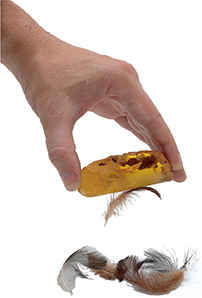Quick Lab

Investigating Charged Objects
Materials
transparent tape, metric ruler, scissors
Procedure 
Cut two 10-cm pieces of tape. Fold over 1 cm of tape at one end of each piece of tape to form a “handle.”
Hold the pieces of tape by their folded ends so that they are hanging straight down. Then, without letting the pieces of tape touch, slowly bring their sticky sides close together. Record your observations.
Place one piece of tape on a clean surface with the sticky side facing down.
Place the second piece, sticky side down, directly over the first piece, as shown. Press down firmly so the pieces stick together.
Remove the joined strips from the table. Slowly peel the strips apart.
Bring the separated strips close together without touching. Record your observations.
Analyze and Conclude
Drawing Conclusions What can you conclude about the charges on the two pieces of tape after they are separated?
Inferring What other objects have you observed that became charged?
Thomson's Model of the Atom
When some materials are rubbed, they gain the ability to attract or repel other materials. Glass and the amber in Figure 4 have this property. Based on their behavior, such materials are said to have either a positive or a negative electric charge. Objects with like charges repel, or push apart. Objects with opposite charges attract, or pull together.
Some charged particles can flow from one location to another. A flow of charged particles is called an electric current. When you turn on an appliance such as a hair dryer, a current flows from the wall socket through the appliance. Joseph John Thomson (1856–1940), better known as J. J. Thomson, used an electric current to learn more about atoms.
Figure 4 Amber is the hardened form of a sticky, viscous liquid that protects trees from insects and disease. If amber is rubbed with wool, it becomes charged and can attract a feather.
Predicting What will happen to the feather if the amber loses its charge?

Thomson's Experiments
Thomson used a device like the one shown in Figure 5A. At the center of the device is a sealed glass tube from which most of the air has been removed. There is a metal disk at each end of the tube. Wires connect the metal disks to a source of electric current. When the current is turned on, one disk becomes negatively charged and the other disk becomes positively charged. A glowing beam appears in the space between the disks.
Thomson hypothesized that the beam was a stream of charged particles that interacted with the air in the tube and caused the air to glow. In one experiment Thomson did to test his hypothesis, he placed a pair of charged metal plates on either side of the glass tube, as shown in Figure 5B. The plates caused the beam to deflect, or bend, from its straight path. Thomson observed that the beam was repelled by the negatively charged plate and attracted by the positively charged plate.




